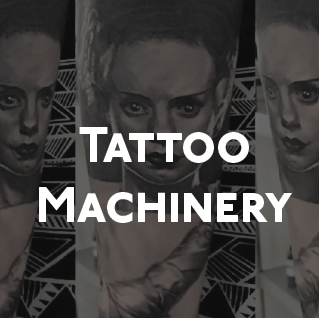
January 4, 2023
Tattoo Machines 101
Intro
Ever wonder about the machine your tattoo artist is using? If you’ve been tattoo multiple times, you may have noticed sometimes the machines look completely different from one another. Maybe you’ve noticed that one session the machine was pretty loud, while another time it was silent. If you’ve sat for a particularly extensive design, you may have spotted several machines being used on you; some of which do not resemble the mainstream media depiction of tattoo machines. We’re here to break it down for you. There several different types of tattoo machines; coil or EM machines, rotary machines, pen machines, and pneumatic machines. They all have pros and cons and which is superior is a heated debate amongst the tattoo community.
Invention of the Tattoo Machine
The first tattoo machine and all it’s variants stem from two inventions with two completely different intentions of use. The initial predecessor to the tattoo machine was an invention by Thomas Alba Edison. Patented under the name “Stencil-Pen” in 1876, the pen was intended to be a duplicating device. It was the first electric pen of its kind, and was rotary operated. This means the pen was powered by a motor that spun in a vertical circle. In 1891, Samuel O’Reilly modified this electric pen to penetrate ink into skin. He eventually patented a tube and needle system to provide an ink reservoir for the electric pen. Thus the first tattoo machine was born.
Although, O’Reilly had previously attempted other designs and modification for a tattoo machine. One particular modification was that of a dental plugger patented under the name “Dentist’s Electro-Magnetic Mallet.” This was a handheld machine designed for impacting gold into cavities. The machine was operated using two vertical electromagnetic coils. It was the basis for the coil tattoo machine known and used today – though its original application was unsuccessful.
Coil Machines
Coil machines are the most commonly portrayed tattoo machine in mainstream media. These machines use electromagnetic coils to move a needle bar up and down. Typically, there can be between 8 to 10 coil wraps. The coils create resistance used to regulate the machines power and speed.
Coil machines come in three different variations; liner coil machine, shader coil machine, and color packer coil machine. Each have different modifications which allow the artist to achieve successful application of your tattoo. To know how to property run these machines, artist must be knowledgeable and adaptable.
- Liner Coil Machine:
These machines are designed and used to pull lines. The machine uses a short contact circuit between 1.5mm – 2 mm. Meaning the needle bar is shorter allowing for a faster cycle. This allows the needle to hit the skin faster, making it easier to pull lines. - Shader Coil Machine:
These machines hit the skin much slower than a liner. With the contact circuit sitting between 2mm – 3.5mm, the slower cycle lessens the saturation level. This allows the artist to slowly build smoother shading by not packing too much ink into the skin. Because it hits the skin softer, it also allows for lines to be retraced with less trauma to the skin. - Color Packing Coil Machine
This variant hits the skin fastest. It packs color deep and hard, willing the color to remain longer in the skin. Because of its speed, the ink has high saturation and tends to pack more evenly. It does not pack as precisely as a shader, there for its not rec0mmended for black and grey shading.
Rotary Machines
Like it’s original form created by O’Reilly, rotary machines used today operate by a powered motor. The motor spins in a vertical circle, driving the needle up and down. These machines are considered to be very convenient, working with a cartridge system allowing artists to easily switch out needle types while in the process of tattooing. This allows the artists to get away with having one or two machines at most. Because of their versatile nature they typically cost around 800 dollars. They typically take a lower level of knowledge to run correctly than a coil machine.
Depending on the artist, the rotary offers many advantages. The machine makes virtually no sound, and has less vibration than a coil machine. Some tattoo artists may tell you they love the sound of a coil machine, while others find it distracting and stress inducing for their clients. In addition, with less vibration and more lightweight, the machine causes less pain in fingers and wrists. Some artist prefer the weight and vibration of coil machines – its all a matter of preference.
Pen Machine
The pen tattoo machine is a variant of a rotary machine. The motor is inside the machine’s tube, and the machine has the appearance of a thick pen. Like a rotary machine, the pen uses the cartridge system allowing for interchangeable needles during session. Artist like the similarity of its pen shape with the benefits of a rotary machine. These machines are easy to clean and disinfect.
Pneumatic Machine
Pneumatic machines are of the newest to the tattoo industry, invented in 200 by Carson Hill. This machine is the most silent of them all thanks to its operation using compressed air. There is very little vibration, and the pressure of air controls the needles speed. In addition, the machine is extremely lightweight. Because the machine has very little internal mechanism sensitive to erosion, the machine is easy to disinfect and clean.
Conclusion
There are several types of tattoo machines, and each machine has its own variants. Every machine offers benefits and cons, and preference in highly dependent on the artists and their skill level. Mastering all of them is achievable as well as impressive, as each runs differently. Next time you’re on the chair, check out the types of machines your artist is using.
Sources:
https://creativeinktattoo.com/2021/01/25/anatomy-of-coil-tattoo-machines/
